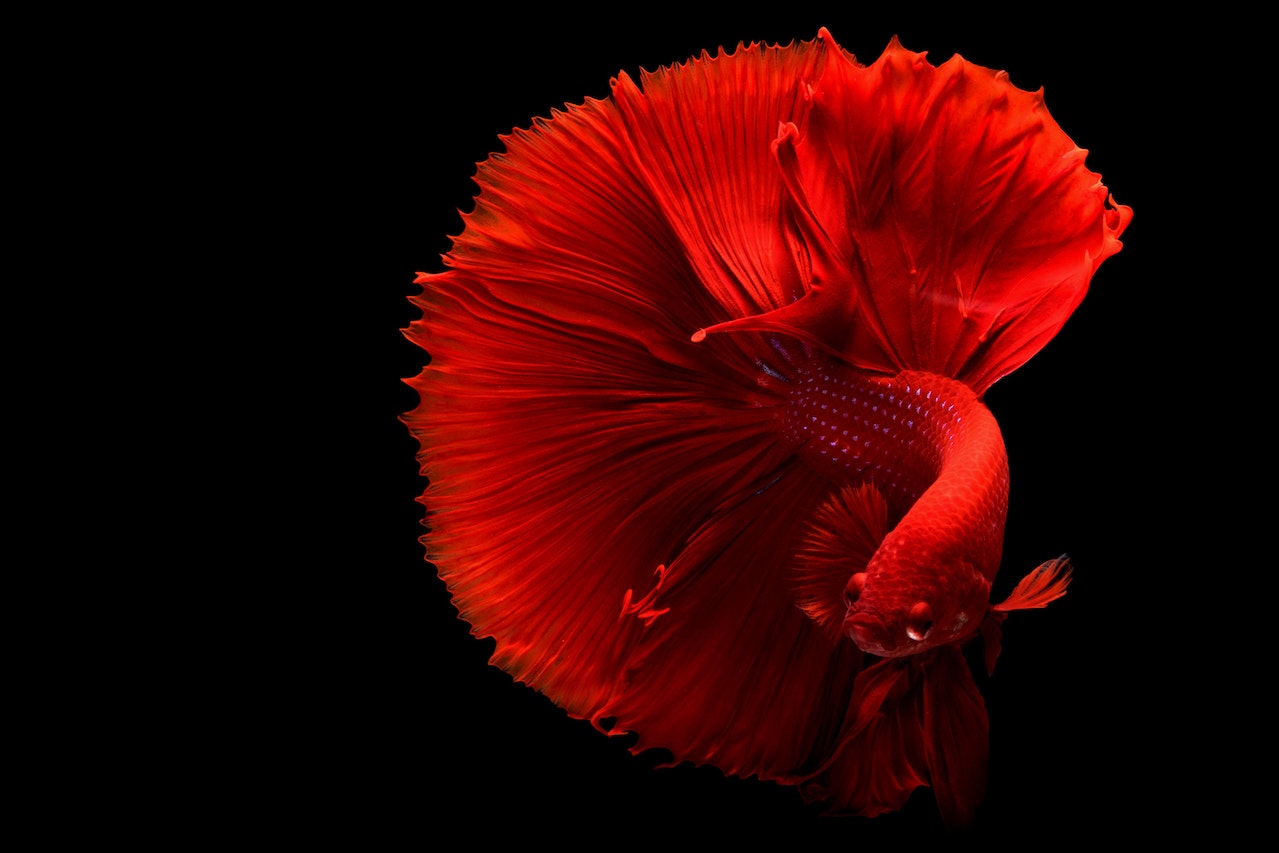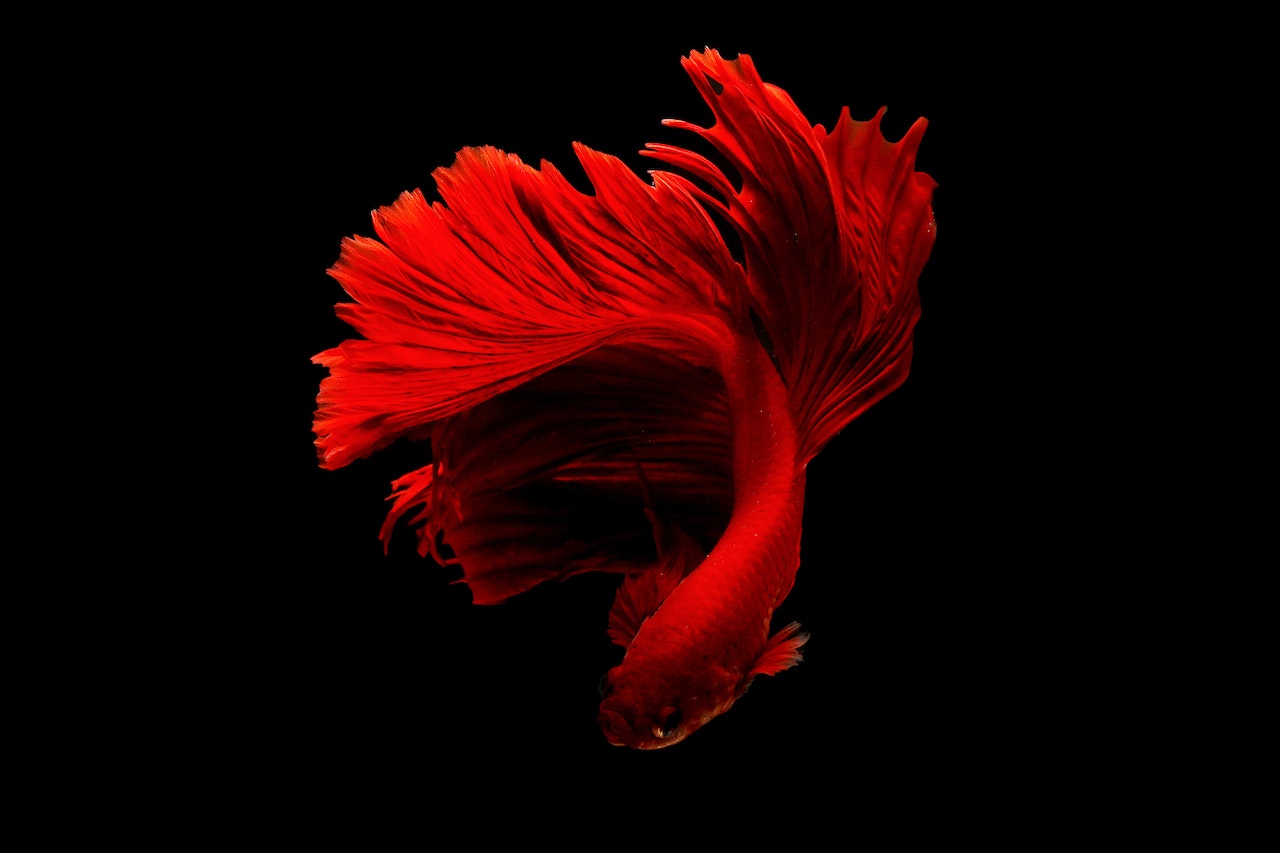The red betta fish is a fascinating creature that can be found in a wide range of colors and sizes.
In this article, we’ll explore the red betta fish species in detail and you’ll find out what makes them so unique.

Red Betta Fish
A red betta fish is a type of Siamese fighting fish that is popular in the aquarium trade. They are known for their vibrant red coloration and long fins.
Red bettas are native to Thailand and were first exported to the United States in the early 1900s.
Red bettas are generally peaceful fish, but they can be aggressive toward other fish with similar coloration.
They are best kept in single-species tanks or with other peaceful fishes. Red bettas require a diet of live or frozen foods, such as brine shrimp, daphnia, or bloodworms.
 Photo by Chevanon Photography from Pexels
Photo by Chevanon Photography from Pexels
How to Care for a Red Betta Fish
Assuming you have already decided to get a red betta fish, congratulations! These beautiful creatures make amazing pets.
In this section, we will go over everything you need to know about how to care for your new red betta fish friend.
Betta fish are tropical freshwater fish that come from Southeast Asia. They prefer warm water, so an ideal water temperature for them is between 77 and 82 degrees Fahrenheit.
You can use a water heater to maintain the correct temperature in your tank.
It is best to keep betta fish in tanks that are at least 2.5 gallons, but 5 gallons or more is even better.
A larger tank will allow your betta fish more room to swim around and explore, and it will also help to stabilize the water quality in the tank.
Be sure to use a good filter in your tank as well; bettas are very sensitive to changes in water quality.
Your red betta fish will also need some hiding places in its tank. Try adding some live plants or driftwood for it to hide behind or under.
A cave or other type of shelter can also provide your betta with a place to feel safe and secure.
Bettas are carnivores, so their diet should consist mostly of meaty foods like bloodworms, brine shrimp, and daphnia.
You can find these foods either frozen or live at your local pet store. You can also feed your betta pellets designed specifically for carnivorous
Feeding Your Betta Fish
When it comes to feeding your betta fish, there are a few things you need to keep in mind. First and foremost, bettas are carnivores, so their diet should consist mainly of meat.
However, they also require some vegetation in their diet for proper nutrition. There are a variety of commercial foods available that are specifically designed for bettas and will provide them with all the nutrients they need.
Pellets or granules: These floating foods come in a variety of formulations and sizes. The sinking pellets are better as they do not cloud the water as much as floating pellets when eaten.
Blood worms: These frozen or freeze-dried worms are an excellent source of protein for bettas and most fish love them! Just be sure to thaw or rehydrate them before feeding.
Brine shrimp: Another excellent source of protein, brine shrimp can be bought live, frozen, or freeze-dried. If you buy them live, be sure to rinse them off before feeding as they can carry diseases.
Vegetables: While not required in large amounts, vegetables such as zucchini, lettuce, and spinach can be offered as occasional treats. Be sure to chop them up into small pieces so your betta can easily eat them.
Diseases of the Red Betta Fish
There are a few diseases that can affect the red betta fish
- Camallanus Worms: Camallanus worms are parasitic nematodes that can infect bettas. They attach themselves to the intestine of the fish and feed off of their blood. This can cause anemia and weight loss in affected fish.
- Columnaris: Columnaris is a bacterial infection that affects the skin and gills of fish. It is often fatal if left untreated.
- Fin Rot: Fin rot is a bacterial infection that causes the fins and tail to rot away. It is often fatal if left untreated.
- Swim Bladder Disease: Swim bladder disease is a condition that affects the swim bladder, which is responsible for ensuring that the fish stays buoyant. Fish with swim bladder disease may sink to the bottom of the tank or have difficulty swimming properly.
- Tetrahymena: Tetrahymena is a parasitic protozoan that can infect bettas. It attaches itself to the mouth and gills of the fish and feeds off of their blood. This can cause anemia and weight loss in affected fish.
Treatment for these diseases will vary depending on the specific condition. It is important to consult a veterinarian if your betta fish shows any signs of illness.
Tank set up for Red Betta Fish
Here are some of the Tips and step-by-step guides you can follow to set up a tank for Red Betta fish.

When it comes to setting up a tank for your red betta fish, there are a few key things to keep in mind.
- The first is that the tank size should be no smaller than 2.5 gallons; anything smaller than this will likely result in poor water quality and unhealthy living conditions for your fish.
- Second, it’s important to maintain a consistent water temperature within the ideal range for red bettas of 76 to 82 degrees Fahrenheit; fluctuations outside of this range can cause stress and illness in your fish.
- Third, every betta tank should include both a filter and an air stone to ensure proper filtration and aeration of the water; without these elements, ammonia and other toxins can quickly build up to harmful levels.
- Fourth, be sure to decorate your red betta’s tank with plenty of hiding places and plants; not only will this provide them with some much-needed security, but the plants will also help to oxygenate the water and keep it clean.
- Finally, remember that your red betta’s diet should consist of high-quality dry food, live food, and frozen food; variety is important to keep them healthy and happy.
When done correctly, setting up a tank for your red betta fish can be a fun and rewarding experience.
By following the tips above, you can ensure that your fish has everything they need to thrive in their new home.
The lifespan of Red Betta Fish
The average lifespan of a red betta fish is 2-3 years. However, with proper care and treatment, they can live up to 5 years or more.
The key to prolonging their lifespan is providing them with a clean and spacious living environment, as well as a healthy diet.
In the wild, red betta fish typically have a shorter lifespan due to the lack of clean water and food sources.
They are also more susceptible to diseases and predators. However, in captivity, they can live much longer as long as their basic needs are met.
Red betta fish is not known to be particularly prone to any health problems. However, like all fish, they can develop health issues if their environment is not clean or if they are not well-fed.
Some common health problems that affect red betta fish include fin rot, body flukes, and gill parasites.
To prevent these health problems, it is important to keep their tank clean and provide them with a well-balanced diet.
If you notice any signs of illness in your red betta fish, it is important to take them to a veterinarian as soon as possible for treatment.
Breeding Red Betta Fish
When it comes to breeding red betta fish, there are a few things you need to take into consideration.
The first is that they are a bit more difficult to breed than other betta fish colors. This is because their coloration is the result of a genetic mutation, and so their offspring are not always guaranteed to be red.
The second thing to consider is that you will need to provide them with plenty of hiding places.
This is because they are very shy fish and will get easily stressed if they feel exposed.
If you want to breed red betta fish, the best thing to do is to find a pair that are already the same color.
This way, you can be sure that their offspring will also be red. Once you have found a suitable pair, you will need to set up a breeding tank for them.
This should be at least 10 gallons in size and should have plenty of plants and hiding places.
The next step is to induce spawning by raising the water temperature and adding some live food into the tank.
Once the female has laid her eggs, she will need to be removed from the tank as the male betta fish will become very aggressive towards her.
The eggs will hatch after around 3 days and the fry will need to be fed on small live foods such as brine shrimp nauplii.
Red betta fish is a beautiful coloration of this popular species and make a great addition to any aquarium.
They are not the easiest fish to breed, but with a bit of patience, you should be able to successfully breed your own red bettas.
What is the Price of Red Betta fish?
The price of red betta fish can vary depending on a few factors, including the size of the fish, quality, and where you purchase them from.
On average, a small red betta fish will cost around $5, while a larger one can cost up to $30. The quality of the fish also plays a role in pricing, with higher-quality fish costing more.
Finally, where you buy your red betta fish can also affect the price. Pet stores typically charge more than online retailers or specialty shops.
When considering the price of red betta fish, factor in all these variables to ensure you get the best deal possible!
What type of tank do I need for a Red Betta fish?
If you’re looking to keep a Red Betta Fish, also known as Betta Splendens, then you’ll need to provide them with an appropriate home.
In the wild, these fish live in small puddles and rice paddies in Southeast Asia, so they’re used to living in close quarters. A small tank is therefore ideal – something around 10 gallons should do the trick.
To create a naturalistic environment for your fish, you can use gravel or sand as a substrate and include some plants.
Live plants are best, but fake plants can work too. Just make sure that the plants are safe for aquariums and that they won’t disturb the delicate ecosystem you’re trying to create.
When it comes to filtration, you have a few options. An internal filter is a good choice for smaller tanks, while a canister filter is better for larger ones.
Whichever option you choose, make sure that the flow rate isn’t too strong for your Red Betta Fish – they’re not fans of strong currents.
Finally, don’t forget to add a heater to your tank. Red Betta Fish like their water on the warm side, around 78-80 degrees Fahrenheit.
Should I keep my red betta in a tank or bowl?
When it comes to keeping red bettas, there is a lot of debate on whether it is better to keep them in a tank or bowl.
There are pros and cons to both options, so it really depends on your personal preference.
If you decide to keep your red betta in a tank, there are a few things you need to take into consideration.
First of all, you will need to get a tank that is big enough for your fish to swim around comfortably.
A too-small tank can cause stress and health problems for your fish. Secondly, you need to make sure the water quality in the tank is good.
This means regular water changes and filtering. A dirty tank can also lead to health problems for your fish.
If you decide to keep your red betta in a bowl, there are a few things you need to take into consideration as well.
First of all, you need to make sure the bowl is big enough for your fish to swim around comfortably.
A too-small bowl can cause stress and health problems for your fish. Secondly, you need not worry about the water quality as much since bowls don’t require filtering as tanks do.
However, you will still need to do regular water changes to keep the water clean and fresh for your fish.
In the end, it really comes down to personal preference. If you are someone who likes to have a lot of control over the environment your fish lives in, then a tank is probably the better option for you.
However, if you don’t want to deal with all the maintenance that comes with a tank, then a bowl might be the better option.
Habitat of Red Betta Fish
Red betta fish are native to Thailand, where they live in slow-moving waters with plenty of vegetation.

They typically inhabit rice paddies, canals, and other stagnant bodies of water. In the wild, red bettas are not always red; they can also be brown, green, or blue.
Red bettas prefer warm water and will do best in an aquarium that is kept between 77 and 86 degrees Fahrenheit.
They should have plenty of hiding places among plants and rocks, as well as some open space to swim.
A good rule of thumb is to provide at least 10 gallons of water per fish.
Red bettas are not especially social fish, so they should be kept in a single-species aquarium or with other peaceful fish that are too large to be considered prey.
Suitable tankmates include gouramis, dwarf cichlids, and barbs. Red bettas are not recommended for community tanks because they may become aggressive toward other fish.
The behavior of Red Betta Fish
Red betta fish are known for their vibrant coloration and active nature. They are a popular choice for aquariums and make excellent pets.
Despite their small size, they are hardy fish that can live for several years with proper care.
Red bettas are very active, playful fish that enjoy interacting with their owners. They are curious and inquisitive, often investigating anything new in their environment.
They are also known to be selectively social, preferring the company of other red bettas or peaceful fish species.
While they are not aggressive by nature, red bettas will defend their territory if necessary.
Males in particular are known to be territorial and may become aggressive toward other males if they feel their territory is threatened.
If you keep multiple red bettas together, it is important to provide plenty of hiding places and give them each plenty of personal space to avoid any aggression.
In the wild, red bettas inhabit rice paddies and slow-moving streams in Southeast Asia. They prefer warm, murky water with plenty of vegetation to hide in.
In captivity, they should be kept in an aquarium with similar conditions; a heated tank with soft water and plenty of plants is ideal.
Red bettas are not strong swimmers and do not do well in fast-flowing water, so a gentle filter is all that is needed to provide adequate filtration.
As with all betta species, red bettas must have access to the surface of the water in order to breathe.
They have a specialized organ called a labyrinth that allows them to take in oxygen from the air, so they must be able to reach the surface easily.
A floating plant or piece of driftwood can provide a resting place for them and help them feel more secure in their environment.
Red bettas are omnivorous and will eat a variety of foods, but they should have a diet that is high in protein.
Commercial betta pellets or flakes are a good base for their diet, and they will also enjoy live or frozen foods such as brine shrimp, daphnia, or bloodworms.
Vegetables such as zucchini, lettuce, or spinach can also be offered as occasional treats.
Red bettas are relatively easy to care for and make great pets for both beginners and experienced fishkeepers alike. With proper care, they can live for several years in captivity.
Conclusion
The red betta fish is a beautiful and unique species that makes a great addition to any aquarium.
They are relatively easy to care for, but it is important to research their specific needs before purchasing one.
With the right care, a red betta fish can be a vibrant and long-lived addition to your home.

